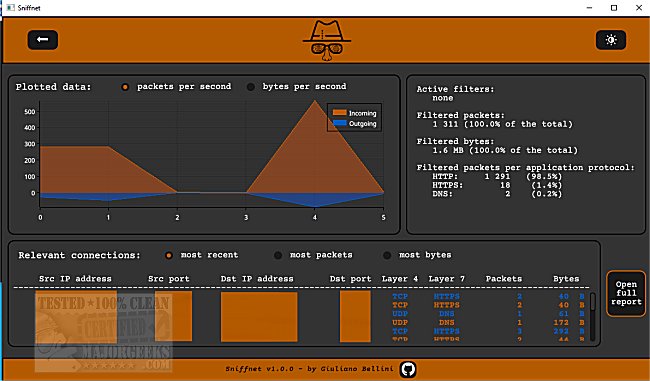Sniffnet version 1.4.1 has been released, offering users a powerful tool for live network traffic monitoring. This multiplatform application features an intuitive interface that allows users to effortlessly track their network activity in real-time. Sniffnet provides a comprehensive overview of network traffic and can generate detailed reports in .txt format, which include essential information such as connection details, source and destination IP addresses and ports, protocols used, and the volume of data exchanged, along with timestamps for the start and end of data transfers.
The application supports various adapter types and enables users to select specific targets for monitoring. Users can apply traffic filters, analyze recorded statistics, and view the most relevant connections based on criteria like recency or data volume. Sniffnet also includes a real-time chart that visualizes traffic intensity, showing both incoming and outgoing data in terms of bytes and packets per second. This feature helps users quickly identify any spikes or potential issues in their network traffic.
By default, Sniffnet is set in dark mode, but users have the option to switch to a light mode if they prefer. The developer has provided download links and notes on any dependencies required for installation on the repository page.
In addition to Sniffnet, users may find value in related topics such as monitoring internet upload and download speeds on the taskbar, assessing network adapter speeds in Windows 10/11, utilizing the ping command, understanding Windows Auto-Tuning, resetting network settings in Windows, and configuring preferred bands (2.4 GHz or 5 GHz) for wireless network adapters.
To enhance the monitoring experience, future updates could introduce features like customizable alerts for unusual traffic patterns, integration with other network management tools, and an expanded database of common protocols for better analysis. Moreover, implementing machine learning algorithms could provide predictive analytics, helping users preemptively address potential network issues before they escalate
The application supports various adapter types and enables users to select specific targets for monitoring. Users can apply traffic filters, analyze recorded statistics, and view the most relevant connections based on criteria like recency or data volume. Sniffnet also includes a real-time chart that visualizes traffic intensity, showing both incoming and outgoing data in terms of bytes and packets per second. This feature helps users quickly identify any spikes or potential issues in their network traffic.
By default, Sniffnet is set in dark mode, but users have the option to switch to a light mode if they prefer. The developer has provided download links and notes on any dependencies required for installation on the repository page.
In addition to Sniffnet, users may find value in related topics such as monitoring internet upload and download speeds on the taskbar, assessing network adapter speeds in Windows 10/11, utilizing the ping command, understanding Windows Auto-Tuning, resetting network settings in Windows, and configuring preferred bands (2.4 GHz or 5 GHz) for wireless network adapters.
To enhance the monitoring experience, future updates could introduce features like customizable alerts for unusual traffic patterns, integration with other network management tools, and an expanded database of common protocols for better analysis. Moreover, implementing machine learning algorithms could provide predictive analytics, helping users preemptively address potential network issues before they escalate
Sniffnet 1.4.1 released
Sniffnet allows live network traffic monitoring through an easy-to-navigate interface.


